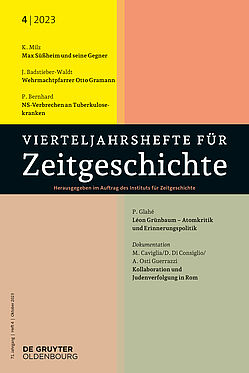- The Institute
- Research
- Dictatorships in the 20th Century
- Democracies and their Historical Self-Perceptions
- Transformations in Most Recent History
- International and Transnational Relations
- Edited Source Collections
- Dissertation Projects
- Completed Projects
- Dokumentation Obersalzberg
- Center for Holocaust Studies
- Berlin Center for Cold War Studies
- Publications
- Vierteljahrshefte
- The Archives
- Library
- Center for Holocaust Studies
- News
- Dates
- Press
- Recent Publications
- News from the Institute
- Topics
- Munich 1972
- Confronting Decline
- Feminist, Pacifist, Provocateur
- Der Mauerbau als Audiowalk
- Digital Contemporary History
- Transportation in Germany
- Envisaged Futures at the End of the Cold War
- From the Reichsbank to the Bundesbank
- German Federal Chancellery
- History of Sustainabilities: Discourses and Practices since the 1970s
- Changing Work
- Democratic Culture and the Nazi Past
- The History of the Treuhandanstalt
- Foreign Policy Documentation (AAPD)
- Dokumentation Obersalzberg
- Hitler, Mein Kampf. A Critical Edition
- "Man hört, man spricht"
- IfZ
- Vierteljahrshefte
- VfZ Archive
- Issue Index
- 2023
- Issue October 2023
Issue 4/2023
Content Overview: English Titles and Abstracts:
- Kristina Milz, The Genesis of a Concept of the Enemy. The Jewish Social Democrat Max Süßheim and His Opponents. - A deeper look into the issue, Newspaper article Süddeutsche Zeitung
- Julika Badstieber-Waldt, Between Wehrmacht Parish and Prison Cell. Wehrmacht Chaplain Otto Gramann in Occupied Belgium/Northern France, 1940 to 1944. - Newspaper article Welt am Sonntag
- Patrick Bernhard, The Punishment That Never Came. National Socialist Crimes against Tuberculosis Patients, West German Prosecutions and the Construction of “Normality” after 1945.
- Philipp Glahé, Nazi Continuities or Personal Mythmaking? The Physicist Léon Grünbaum and the Karlsruhe Nuclear Research Centre between Antifascist Nuclear Criticism and the Politics of Memory.
- Marco Caviglia/David Di Consiglio/Amedeo Osti Guerrazzi, The “Black Panther” on Trial. Collaboration and Persecution of Jews in Rome in the Mirror of Italian Trial Records.
Abstracts
Kristina Milz, The Genesis of a Concept of the Enemy. The Jewish Social Democrat Max Süßheim and His Opponents
In the early Stürmer, Max Süßheim (1876–1933) from Nuremberg is omnipresent: During the mid-1920s there was hardly a single issue of the smear sheet which neglected to refer to the Social Democrat, who as a lawyer was among the early opponents of National Socialism. As a politician Süßheim had played an important role during the revolution of 1918/19; to date he remains the last Jewish member of the Bavarian parliament. How could such a figure be forgotten even within his own political party? Kristina Milz places the Jewish Social Democrat with a bourgeois background into the context of pre-democratic and early democratic Bavaria and exposes his enemies’ identity-centred line of argumentation, which, whether coming from the left or the right, always reduced Süßheim to his heritage.
Julika Badstieber-Waldt, Between Wehrmacht Parish and Prison Cell. Wehrmacht Chaplain Otto Gramann in Occupied Belgium/Northern France, 1940 to 1944
Even though the history of the Wehrmacht during the Second World War has been intensively explored, there still are gaps, including the role of Wehrmacht chaplains in German-occupied Europe. Julika Badstieber-Waldt deals with the topic using the example of the Austrian Wehrmacht Senior Chaplain Otto Gramann, who was deployed in Belgium and Northern France between 1940 and 1944. Her article demonstrates how the role of Wehrmacht chaplains changed and became progressively complex over time. While the Wehrmacht chaplain service was originally only designed for German soldiers, prisoners and convicts on death row in the western occupied territories were soon placed in their care as well. Using impressive sources from Gramann’s papers, Julika Badstieber-Waldt depicts his activities between military congregation and prison cell, which drew an extraordinary degree of attention during the post-war period.
Patrick Bernhard, The Punishment That Never Came. National Socialist Crimes against Tuberculosis Patients, West German Prosecutions and the Construction of “Normality” after 1945
Persons suffering from tuberculosis are among the forgotten victims of the Nazi dictatorship. One of the reasons for this was the fact that cases of intentional patient neglect, physical violence and finally murder were not prosecuted after 1945 insofar as they pertained to German victims. Patrick Bernhard inquires into the reasons for this and – by using newly treated sources – points to a lack of will to deal with crimes which did not take place in concentration camps or institutions understood to be genuinely National Socialist. Thus, the approach of the involved jurists can be interpreted as a successful attempt to enclose National Socialism and the crimes committed in its name by reducing them to certain criminal acts, perpetrators and crime scenes. The article thereby also describes how “normality” was constructed in West German society.
Philipp Glahé, Nazi Continuities or Personal Mythmaking? The Physicist Léon Grünbaum and the Karlsruhe Nuclear Research Centre between Antifascist Nuclear Criticism and the Politics of Memory
In 2012 the Karlsruhe Nuclear Research Centre made the headlines when it became public knowledge that the jurist Rudolf Greifeld, managing director of the Kernforschungszentrum Karlsruhe (KfK) between 1956 and 1974, was listed as honorary senator of the university. In 1975 there had been a scandal regarding Greifeld, when the former KfK employee Léon Grünbaum together with Beate and Serge Klarsfeld published an antisemitic memorandum written by Greifeld in 1941. In an unpublished manuscript Grünbaum investigated the continuities among the personnel in German nuclear research and accused Greifeld of being an unexposed Nazi criminal. The accusations were refuted repeatedly by research, which, however, was hardly noted in the public debate in Karlsruhe.
Marco Caviglia/David Di Consiglio/Amedeo Osti Guerrazzi, The “Black Panther” on Trial. Collaboration and Persecution of Jews in Rome in the Mirror of Italian Trial Records
Celeste Di Porto gained notoriety as the “Black Panther”. The young Jewess from Rome had joined a group of Italian collaborators in 1944, who tracked down hidden Jews in the Eternal City to betray them to the Germans and earn the bounty. At the centre of the documentation is the judgment passed by a jury court in Rome in 1947 against Celeste Di Porto and her accomplices. This opinion, which is an example of a source material hitherto mostly unknown to German historiography, allows for a reconstruction of the practices of the group around the “Black Panther” as well as the mechanisms of collaboration between the German bureaucracy of extermination and their willing Italian helpers. Additionally, the verdict highlights how post-war Italian society dealt with Fascism, collaboration and the persecution of the Jews.









